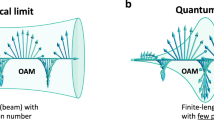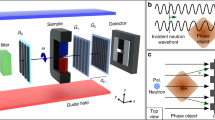Abstract
The quantized orbital angular momentum (OAM) of photons1 offers an additional degree of freedom and topological protection from noise. Photonic OAM states have therefore been exploited in various applications2,3 ranging from studies of quantum entanglement and quantum information science4,5,6,7 to imaging8,9,10,11,12. The OAM states of electron beams13,14,15 have been shown to be similarly useful, for example in rotating nanoparticles and determining the chirality of crystals16,17,18,19. However, although neutrons—as massive, penetrating and neutral particles—are important in materials characterization, quantum information and studies of the foundations of quantum mechanics, OAM control of neutrons has yet to be achieved. Here, we demonstrate OAM control of neutrons using macroscopic spiral phase plates that apply a ‘twist’ to an input neutron beam. The twisted neutron beams are analysed with neutron interferometry. Our techniques, applied to spatially incoherent beams, demonstrate both the addition of quantum angular momenta along the direction of propagation, effected by multiple spiral phase plates, and the conservation of topological charge with respect to uniform phase fluctuations. Neutron-based studies of quantum information science20,21, the foundations of quantum mechanics22,23, and scattering and imaging24 of magnetic, superconducting and chiral materials have until now been limited to three degrees of freedom: spin, path and energy. The optimization of OAM control, leading to well defined values of OAM, would provide an additional quantized degree of freedom for such studies.
This is a preview of subscription content, access via your institution
Access options
Subscribe to this journal
Receive 51 print issues and online access
$199.00 per year
only $3.90 per issue
Buy this article
- Purchase on Springer Link
- Instant access to full article PDF
Prices may be subject to local taxes which are calculated during checkout




Similar content being viewed by others
References
Allen, L., Beijersbergen, M. W., Spreeuw, R. J. C. & Woerdman, J. P. Orbital angular momentum of light and the transformation of Laguerre-Gaussian laser modes. Phys. Rev. A 45, 8185–8189 (1992)
Yao, A. M. & Padgett, M. J. Orbital angular momentum: origins, behavior and applications. Adv. Opt. Photon. 3, 161–204 (2011)
Torres, J. P. & Torner, L. Twisted Photons: Applications of Light with Orbital Angular Momentum (Wiley-VCH, 2011)
Mair, A., Vaziri, A., Weihs, G. & Zeilinger, A. Entanglement of the orbital angular momentum states of photons. Nature 412, 313–316 (2001)
Vallone, G. et al. Free-space quantum key distribution by rotation-invariant twisted photons. Phys. Rev. Lett. 113, 060503 (2014)
Yu, S. Potentials and challenges of using orbital angular momentum communications in optical interconnects. Opt. Express 23, 3075 (2015)
Cardano, F. et al. Quantum walks and wavepacket dynamics on a lattice with twisted photons. Sci. Adv. 1, e1500087 (2015)
Hell, S. W. Far-field optical nanoscopy. Science 316, 1153–1158 (2007)
Bahrdt, J. et al. First observation of photons carrying orbital angular momentum in undulator radiation. Phys. Rev. Lett. 111, 034801 (2013)
Takahashi, Y. et al. Bragg x-ray ptychography of a silicon crystal: visualization of the dislocation strain field and the production of a vortex beam. Phys. Rev. B 87, 121201 (2013)
Gariepy, G. et al. Creating high-harmonic beams with controlled orbital angular momentum. Phys. Rev. Lett. 113, 153901 (2014)
Fischer, P. X-ray imaging of magnetic structures. IEEE Trans. Magn. 51, 0800131 (2014)
Uchida, M. & Tonomura, A. Generation of electron beams carrying orbital angular momentum. Nature 464, 737–739 (2010)
Verbeeck, J., Tian, H. & Schattschneider, P. Production and application of electron vortex beams. Nature 467, 301–304 (2010)
McMorran, B. J. et al. Electron vortex beams with high quanta of orbital angular momentum. Science 331, 192–195 (2011)
Schattschneider, P., Löffler, S., Stöger-Pollach, M. & Verbeeck, J. Is magnetic chiral dichroism feasible with electron vortices? Ultramicroscopy 136, 81–85 (2014)
Rusz, J., Bhowmick, S., Eriksson, M. & Karlsson, N. Scattering of electron vortex beams on a magnetic crystal: towards atomic-resolution magnetic measurements. Phys. Rev. B 89, 134428 (2014)
Juchtmans, R., Béché, A., Abakumov, A., Batuk, M. & Verbeeck, J. Using electron vortex beams to determine chirality of crystals in transmission electron microscopy. Phys. Rev. B 91, 094112 (2015)
Shiloh, R. et al. Unveiling the orbital angular momentum and acceleration of electron beams. Phys. Rev. Lett. 114, 096102 (2015)
Pushin, D. A., Huber, M. G., Arif, M. & Cory, D. G. Experimental realization of decoherence-free subspace in neutron interferometry. Phys. Rev. Lett. 107, 150401 (2011)
Wood, C. J. et al. Quantum correlations in a noisy neutron interferometer. Phys. Rev. A 90, 032315 (2014)
Klepp, J., Sponar, S. & Hasegawa, Y. Fundamental phenomena of quantum mechanics explored with neutron interferometers. Prog. Theor. Exp. Phys. 2014, 082A01 (2014)
Rauch, H. & Werner, S. A. Neutron Interferometry: Lessons in Experimental Quantum Mechanics, Wave-Particle Duality, and Entanglement 2nd edn, Vol. 12 (Oxford Univ. Press, 2015)
Pfeiffer, F. in Neutron Imaging Applications: A Reference for the Imaging Community (eds Anderson, I. S. et al.) Ch. 8 (Springer, 2009)
Peele, A. G. et al. X-ray phase vortices: theory and experiment. J. Opt. Soc. Am. A 21, 1575–1584 (2004)
Pushin, D. A., Arif, M., Huber, M. G. & Cory, D. G. Measurements of the vertical coherence length in neutron interferometry. Phys. Rev. Lett. 100, 250404 (2008)
Granada, J. Slow neutron total cross-section of Al6061 at low temperatures. J. Nucl. Mater. 277, 346–350 (2000)
Pushin, D. A., Cory, D. G., Arif, M., Jacobson, D. L. & Huber, M. G. Reciprocal space approaches to neutron imaging. Appl. Phys. Lett. 90, 224104 (2007)
Pushin, D. A. et al. Neutron interferometry at the National Institute of Standards and Technology. Adv. High Energy Phys. 2015, 687480 (2015)
Dietze, M., Felber, J., Raum, K. & Rausch, C. Intensified CCDs as position sensitive neutron detectors. Nucl. Instrum. Meth. A 377, 320–324 (1996)
Arif, M., Brown, D. E., Greene, G. L., Clothier, R. & Littrell, K. Multistage position-stabilized vibration isolation system for neutron interferometry. Proc. SPIE Int. Soc. Opt. Eng. 2264, 20–26 (1994)
Hasegawa, Y., Loidl, R., Badurek, G., Baron, M. & Rauch, H. Violation of a Bell-like inequality in single-neutron interferometry. Nature 425, 45–48 (2003)
Bartosik, H. et al. Experimental test of quantum contextuality in neutron interferometry. Phys. Rev. Lett. 103, 040403 (2009)
Sponar, S., Klepp, J., Zeiner, C., Badurek, G. & Hasegawa, Y. Violation of a Bell-like inequality for spin-energy entanglement in neutron polarimetry. Phys. Lett. A 374, 431–434 (2010)
Hasegawa, Y. et al. Entanglement between degrees of freedom of single neutrons. Nucl. Instrum. Methods Phys. A 611, 310–313 (2009)
Hasegawa, Y. et al. Engineering of triply entangled states in a single-neutron system. Phys. Rev. A 81, 032121 (2010)
Sponar, S. et al. High-efficiency manipulations of triply entangled states in neutron polarimetry. New J. Phys. 14, 53032 (2012)
Sponar, S. et al. Triple entanglement in neutron interferometric and polarimetric experiments. J. Phys. G 340, 012044 (2012)
Pfeiffer, F. et al. Neutron phase imaging and tomography. Phys. Rev. Lett. 96, 215505 (2006)
Strobl, M. et al. Neutron dark-field tomography. Phys. Rev. Lett. 101, 123902 (2008)
Kardjilov, N. et al. Three-dimensional imaging of magnetic fields with polarized neutrons. Nature Phys. 4, 399–403 (2008)
Grünzweig, C. et al. Bulk magnetic domain structures visualized by neutron dark-field imaging. Appl. Phys. Lett. 93, 112504 (2008)
Manke, I. et al. Three-dimensional imaging of magnetic domains. Nature Commun. 1, 125 (2010)
Kardjilov, N., Manke, I., Hilger, A., Strobl, M. & Banhart, J. Neutron imaging in materials science. Mater. Today 14, 248–256 (2011)
Treimer, W. Radiography and tomography with polarized neutrons. J. Magn. Magn. Mater. 350, 188–198 (2014)
Liu, D. et al. Demonstration of achromatic cold-neutron microscope utilizing axisymmetric focusing mirrors. Appl. Phys. Lett. 102, 183508 (2013)
Liu, D. et al. Demonstration of a novel focusing small-angle neutron scattering instrument equipped with axisymmetric mirrors. Nature Commun. 4, 2556 (2013)
Verbeeck, J. et al. Atomic scale electron vortices for nanoresearch. Appl. Phys. Lett. 99, 203109 (2011)
Muhlbauer, S. et al. Skyrmion lattice in a chiral magnet. Science 323, 915–919 (2009)
Acknowledgements
Financial support provided by the NSERC ‘Create’ and ‘Discovery’ programmes, CERC and the NIST Quantum Information Program is acknowledged. We appreciate discussions with B. McMorran, D. Sarenac, S. Werner and K. Wright.
Author information
Authors and Affiliations
Contributions
C.W.C. and D.A.P. conceived the idea of implementing OAM for neutron beams. D.A.P. conceived the idea of using the spiral phase plate and neutron interferometer for OAM implementation, and designed and built the experimental setup. M.A., M.G.H. and D.A.P. conducted the neutron interferometer experiments. R.B., C.W.C., D.G.C. and D.A.P. led the analysis and wrote the manuscript, with M.A. and M.G.H. contributing substantially.
Corresponding author
Ethics declarations
Competing interests
The authors declare no competing financial interests.
Extended data figures and tables
Extended Data Figure 1 Raw data.
Typical images of raw neutron count data obtained over about 80 contiguous hours of data collection with the 2D imaging detector (see Fig. 1). False-colour representation of neutron counts per pixel as indicated by scale on image. On the left is an image of an SPP with L = 0 that is equivalent to a uniform phase plate; on the right is an image of the L = 3 compound SPP discussed in Fig. 3. The horizontal and vertical positions on the 2D neutron detector are shown in millimetres.
Extended Data Figure 2 Data processing.
Illustrations of steps taken to convert raw images collected on the 2D detector to the images shown in Figs 2, 3, 4. a, Raw data. b, Same data, passed through 2D averaging filter with averaging taken over a 10 pixel × 10 pixel square. c, Filtered data normalized to maximum value of intensity in b. The horizontal and vertical positions on the 2D neutron detector are shown in millimetres.
Extended Data Figure 3 Noise distribution.
Illustrations of steps taken to model effects of shot noise in the raw images collected on the 2D detector and images shown in Figs 2, 3, 4. a, Image of the raw data. b, Poisson noise or square root of each pixel shown in a. c, Noise-to-signal ratio of image in a. The horizontal and vertical positions on the 2D neutron detector are shown in millimetres.
Rights and permissions
About this article
Cite this article
Clark, C., Barankov, R., Huber, M. et al. Controlling neutron orbital angular momentum. Nature 525, 504–506 (2015). https://doi.org/10.1038/nature15265
Received:
Accepted:
Published:
Issue Date:
DOI: https://doi.org/10.1038/nature15265
This article is cited by
-
Three-dimensional neutron far-field tomography of a bulk skyrmion lattice
Nature Physics (2023)
-
Phase vortex lattices in neutron interferometry
Communications Physics (2023)
-
Orbital angular momentum detection device for vortex microwave photons
Communications Engineering (2023)
-
Twisted moiré photonic crystal enabled optical vortex generation through bound states in the continuum
Nature Communications (2023)
-
Topologically crafted spatiotemporal vortices in acoustics
Nature Communications (2023)
Comments
By submitting a comment you agree to abide by our Terms and Community Guidelines. If you find something abusive or that does not comply with our terms or guidelines please flag it as inappropriate.



